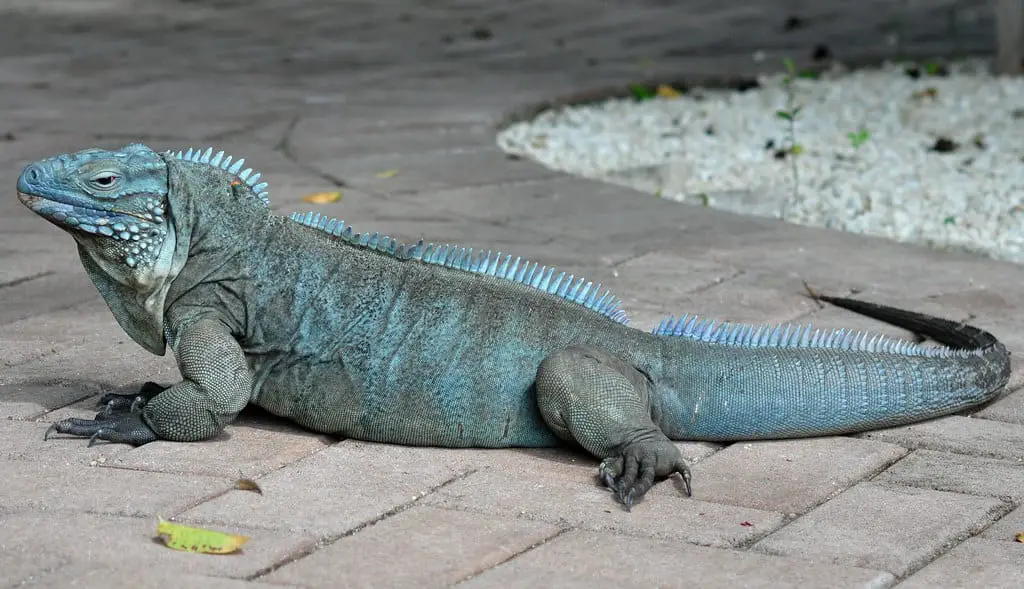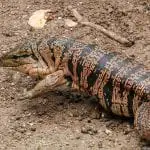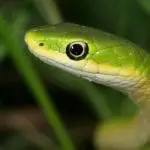Scientific Facts
| Common Name | Grand Cayman Blue Iguana |
| Scientific Name | Cyclura lewisi |
| Habitat | A rocky, open and dry forest where there are near bodies of water |
| Lifespan | 25 to 40 years in captivity; up to 20 years in the wild |
| Size and Weight | 5-7 feet; 30 pounds (15kls) |
| Diet | flowers, fruits, plants and vegetables |
| Color | Males: turquoise blue to dark greyFemales: olive green to pale blue |
Physical Description
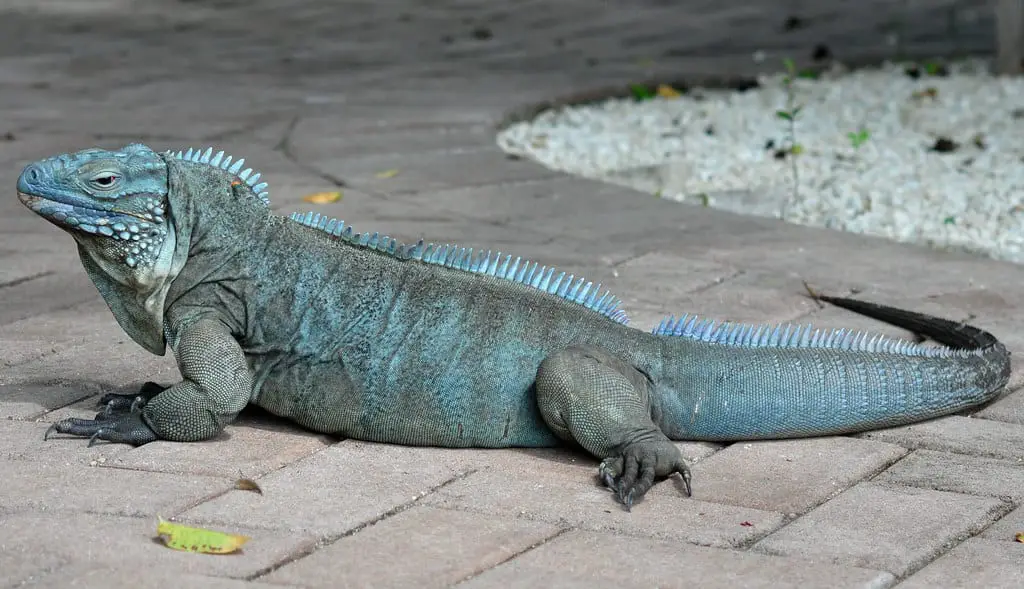
Grand Cayman ground iguana, also is known as blue iguana, has a large physique with a heavy body making it the heaviest in the iguana species. The characteristic that truly stands out is its color; the males have colors that range from turquoise blue to dark grey while females tend to have an olive green to pale blue colorations. During their younger years, they all have a uniformed green or dark brown banding.
In their younger years, their bodies will have eight dark dorsal markings from their necks to their pelvic area, but as they grow, these markings will eventually fade away while slowly showing its blue color attributes. The male blue iguana holds a more prominent coloration. Their feet have black color in contrast with its light-colored body. The blue iguana has an excellent vision where they are able to detect motions and even shapes in long distances. They also have a parietal eye or considered as their third eye, where it is sensitive that can detect movements.
Where it is seen?
As its name implies, it originally lives in the Grand Cayman, which is a part of the Cayman Islands located in the Cuna Republic. You can mostly see them in shrublands, gardens and closed-canopy forests where they can see a lot of food.
Habitat
In the wild, the habitat of blue iguana is in a rocky, open, and dry forest where there are near bodies of water. They occupy tree cavities and rock holes mostly at night to sleep. They thrive well in a sunny and warm environment. The males tend to have a territory of about 1.4 acres (5,700 m2), while the females occupy at least 0.6 acres (2,400 m2). In the wild, there are at least 4-5 blue iguana in one hectare.
Behavior
The blue iguanas are diurnal, where they bask under the sun early in the morning while they hide in caves, rock formation, and other abandoned places. You would often see them head bobbing, which is a form of communication to show if they are threatened, stressed, happy, or excited. One of their distinct characteristics is that they exhibit a turquoise blue color when they are not stressed and when they are happy, but their color changes towards the green hue if they are threatened or cold. They have deep reddish-brown eyes and their heads, tales and scales are black.
You often see them lick the ground or lick the person that they see. If this happens, that is a good sign that they are comfortable and that they are in a good mood. When they lick your finger, that is a sign of submissiveness and friendliness. One of the reasons why iguanas are by nature alert is because they have the third eye is also known as the parietal eye, that even their predator is from above; they can be able to detect it so that they can run away fast.
Diet
The blue iguana is purely herbivores where they feed on flowers, fruits, plants, and vegetables. They are also seen eating some insects such as crabs, slugs, larvae, and dead birds, but it is rare. It is important for them to eat a lot of plants, vegetables, and flowers in one eating because plants contain potassium, for them to get the daily nutritional needs they need to feed on different kinds of plants to achieve the metabolic needs of their bodies. They do not eat cabbage, cauliflower, broccoli, turnips, brussels sprouts, and bok-choy because it is hard to digest.
Size and weight
Blue iguanas are another reptile that is sexually dimorphic, wherein the males tend to be larger than females. Males have more projecting dorsal crests, and they have larger thigh pores where their pheromones are secreted to attract females. The average matured blue iguana weighs more than 30 pounds (15kls.) with a size that ranges from 5-7 feet. This is considered as the largest and heaviest land vertebrate.
Lifespan
In the wild, the average lifespan of blue iguana is about 20 years, but if taken into captivity, they can survive about 25 to 40 years. There is research conducted that there is a blue iguana in the USA that lived in captivity for about 69 years old.
Blue iguanas appear to be a long-lived species, generally surviving for 25 to 40 years in the wild. One male in human care in the U.S. lived to be at least 69 years old. In the wild, green iguanas live about 20 years.
Breeding and Reproduction
The mating starts when the male head-bobs in numerous manners while moving around the female trying to grasps her nape in the neck, and then the male attempts to position the tails of the female under him so that the intromission position is easier. Their copulation will only last for about 30 to 90 seconds, and for some, it happens twice a day. The mating process is done usually between the months of May to June.
Depending on the size of the females, it lays the eggs after a month or two with the number of eggs that ranges from 1-21 eggs. These eggs should be incubated at a temperature of 32 °C (90 °F) for about 65–90 days. The eggs of blue iguana are the largest eggs among lizards. The blue iguanas are considered to be mature when they reach the age of 4.
Availability-Where to Get One?
Blue iguanas are appealing to exotic pet collectors where they also breed. If you want to have one in captivity, you can no longer see any of it in any pet shops whether online or in a physical store because of its conservation status but since it is a favorite among pet collectors, you may need to have research where you can buy a blue iguana, most probably from exotic pet collectors
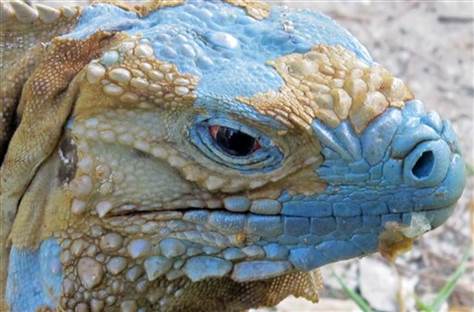
Common Disease/Illnesses
1) Burns
Lighting equipment is necessary for their housing, but when the lights are not properly installed, and if the light required is more than, your iguana may suffer from burns.
2) Wounds
This type of iguana is active, whether it is in the cage, leaps, and jumps; that is why it can’t be avoided to get some wounds if they accidentally bump into a sharp object in there ca, e leading to minor or major wounds. To avoid complications, incurred wounds should be treated right away.
3) Metabolic bone disease
This disease is a result of calcium and vitamin D Deficiency. To address this issue, you may need to ensure that the lights are properly installed and that it should be given the right diet pattern. When your pet suffers from this, it can be a result of being inactive.
4) Dehydration
There are manifestations that your iguana is suffering from dehydration, and that, s if it loses weight quickly, it is no longer moving around, and when their skin develops wrinkles. You can encourage them to drink water by means of using threats in their water bowl.
5) Respiratory problems
It is important to ensure that they are always exposed to warm climates because if there is not enough heat, they may suffer from breathing problems. This health problem can be corrected right away by means of adjusting the temperature.
6) Egg-binding
This happens when your pet is having a hard time laying eggs due to the size and other problems. This problem can be resolved when the iguana is given the right nesting area with a calcium-rich diet on a daily basis.
Preventing Illnesses
It is always important to know what is happening to your pet so that you can attend to their concerns as soon as possible. These diseases and illnesses can’t be avoided, but if attended to right away it can be cured to create a stress-free environment for your pet. Most of the disease that they suffer is due to nutrient deficiency so you must closely monitor their food intake.
Captive Breeding
This blue iguana is not for everyone due to its size and weight. If you would take it into captivity, make sure that you can provide its needs, such as spacious housing with ideal lighting and temperature and supply of healthy food. You must have a 100% dedication to ensure that your pet will live long under your care. If you don’t have a budget, you may create a cage in your backyard to have some space. If you would take a baby blue iguana in captivity, the first years of its life are the most crucial because they are still prone to malnourishment and improper husbandry that is why you need to be careful in handling them from the very first start to prolong their lifespan.
How to Care Reptile as Pet
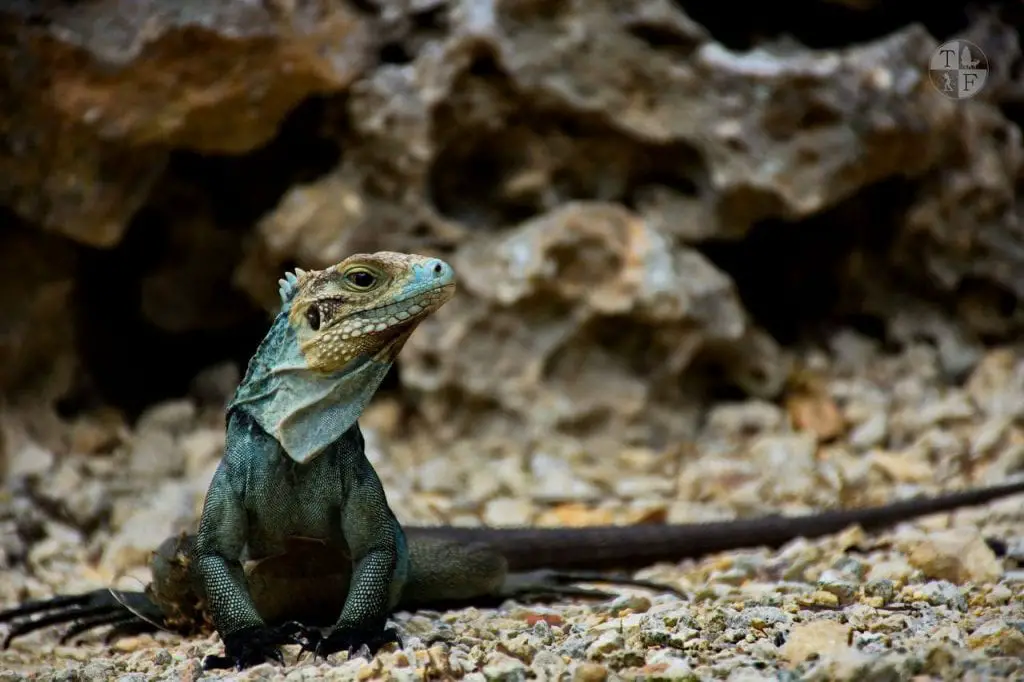
1) Housing
Like other types of iguana, blue iguana needs a lot of space. The ideal cage or aquarium is around 4 feet deep. Even though you’ll get a baby iguana, you are still required to have the ideal size of the tank because it grows rapidly. The blue iguana is fond of outdoor activities; that is why you may need to take them out from their cage once in a while using a lizard leash so that you can still control it wherever it goes.
2) Lighting and temperature
In choosing the right lighting equipment, you must choose those that are UA, and UVB lights since these types of lights produce heat that mimics like that of the sun’s light exposure. Since it is necessary for you to have lights on almost 24/7, you need to have a proper set-up to avoid burning the skin of the iguana. The productivity of these lights also degrades as time goes by; that is it important to change it after 9 months.
Since blue iguana thrives in a hot environment, you may need to install heating lamps or devices to achieve a temperature of about 95 degrees Fahrenheit during the day and at least 75 degrees Fahrenheit at night. Make sure not to overheat the iguana’s tank so as not to cause other problems as well.
3) Food & Water
It is quite easy to feed your pet with animal protein and dairy products in captivity, but it is a no-no for blue iguanas because they are strictly herbivores. They only eat leaves, flowers, fruits, vegetables, and grains. Different treats that you can give them are strawberries, grapes, raspberries, etc. Since these treats are quite expensive, you can do it at least once a week. Their food intake is the only way for them to get in nutrients so be sure to choose healthy foods for them.
Not all vegetables can be given to them, avoid cabbage, broccoli, bok Choi, turnips, cauliflower, brussels sprouts, and tofu because it was found out that it is difficult to be digested. Sometimes blue iguana needs to be trained for them to drink water. Make sure that they have a clean and hygienic water supply to avoid dehydration and so that the food intake will be digested quickly.
4) Getting used to their characteristics
Getting them into captivity doesn’t only mean that you need to give them what they need, but they also need to be loved, cared for. They are smart and intelligent iguanas that can be attached to their owners. However, since they are not into socialization, it is not advisable to place two iguanas in one cage because they are also territorial that can aggressively engage in a deadly fight.
Conservation Status
The blue iguana is already considered as an endangered species. Studies show that there are places around the globe that has no signs of iguanas. There is already a foundation that takes good care of its ongoing conservation. These foundations are still actively breeding these species to increase their populations in the wild before it’s too late. Predation to other animals, illegal hunters, and destruction of their habitats are the great reasons why these species are nearly extinct.
FAQ Section
How smart are they?
These species of iguana can be trained by an expert easily learning a variety of behaviors, making them fairly intelligent. They also have the ability to recognize their owners.
Are blue iguanas aggressive?
It is by nature that iguanas tend to be aggressive at times, especially when they are threatened but they can be tamed easily.
Do the changes in their color has meanings?
Research shows that when a blue iguana is excited, happy, and stress-free they tend to have a turquoise blue color but when they are cold and stressed, their color changes with more prominent greenish pigmentation.
What does it mean when your blue iguana licks you?
When your blue iguana licks you, it means that they are comfortable with your presence, and it shows submissiveness. When your iguana does this to your hands, do not show any signs that you are scared.
Is there a possibility that my blue iguana will turn black?
Yes, this happens when your blue iguana is under psychosocial stress when they are with their iguana; that is why it is not advisable to place two iguanas in one housing. Their color changes from green to dark brown and will slowly turn into black.
What does it mean when a blue iguana closes its eyes?
When a blue iguana closes his eyes in front of you, this is another indication that it is comfortable at your presence. For them, there is no reason for them to be alert; that is why they can close their eyes.
Can blue iguanas sense fear?
You know that your blue iguana is scared if they can’t behave in one place. They may run or hide. It is a problem for pet owners if they can’t control the overwhelming scared feeling that the iguana feels because they can be aggressive and bite.
Do blue iguanas eat meat?
They are not fond of eating meat. There are times when they feed on insects, but these are rare situations. They are considered as folivores where they love to feed on the leaves.
What is the contribution of blue iguana to the environment?
Blue iguanas are pollinators by dispersing the seeds of the fruits and plants that they eat through their poop, making it an important part of their ecosystem.

